|
In a direct-attached library configuration, only Windows and Solaris
MediaAgents can be configured to use the StorageTek library controlled by ACSLS
server. The following procedure describes the steps involved in configuring the STK
library attached to the ACSLS Server as a direct attached library (with or
without SN6000) using the Library and Drive
Configuration window.
|
Before You Begin
|
Pre-configuration tasks in the ACSLS Server computer
Perform the following tasks in the ACSLS Server
on Solaris or STK Library Manager on Windows:
- Ensure that the hardware is configured according to the guidelines
provided in Hardware Configuration Guidelines - STK Libraries Attached to ACSLS Server.
(Solaris and Windows)
- Verify that the ACSLS server is online and the STK library is
functioning. (Solaris and Windows)
NOTES
See the STK/ACSLS documentation for instructions on verifying
the status of the ACSLS Server/STK library.
- In the ACSLS server, create a separate scratch pool in the library for the
exclusive use of the CommCell to which the MediaAgent(s) you wish to
configure are attached. (Solaris)
The MediaAgent uses a designated ACSLS scratch pool as its working media
pool. Make sure that the designated scratch pool contains all the media that
will be used by the MediaAgent. (See also:
Best Practices for STK Libraries Attached to ACSLS Server)
NOTES
See the STK/ACSLS documentation for
instructions on creating the scratch pool and moving the tapes to the
scratch pool.
- Move the necessary tapes into this scratch pool or use the Volume Range
in the Library Properties to add the necessary tapes. (Volume Range
is explained in the following procedure.) (Solaris)
Pre-configuration tasks in SN6000 (if available)
Ensure the following using the SN6000 interface:
- Verify that the drives in the library are visible and configured.
- Mount Queuing is disabled.
Pre-configuration tasks in the MediaAgent computer
- Ensure that the hardware is configured according to the guidelines
provided in Hardware Configuration Guidelines - STK Libraries Attached to ACSLS Server.
- Install one of the following software on a Windows or Solaris MediaAgent
that will act as the library controller. To configure failover library
controllers, install the following software on multiple MediaAgents that
will act as failover library controllers.
- For a Windows MediaAgent, install StorageTek's Library
Attach for Windows on the MediaAgent computer that will be
configured as the Library Controller. Make sure the library is
accessible through the specified ACSLS host server.
NOTES
See the STK/ACSLS documentation for instructions on installing the
Library Attach for Windows.
- For a Solaris MediaAgent, install the ACSLS Client Service. This
service can be installed in one of the following ways:
During the MediaAgent software installation on the Solaris computer. See
Install
the MediaAgent - Solaris for step-by-step instructions on
installing the MediaAgent software on Solaris.
If you have already installed the MediaAgent, you can run the
config_acsls
program on the Solaris MediaAgent computer: See
Install ACSLS Client Service on Solaris for step-by-step instructions .
-
This feature requires a Feature License to be available in the CommServe® Server.
Review general license requirements included in
License Administration. Also,
View All Licenses provides step-by-step
instructions on how to view the license information.
Required Capability: See
Capabilities and Permitted Actions |
Configure a StorageTek library using ACSLS server as a
direct-attached library
|
| 1. |
Display
the Library and Drive Configuration window.
|
|
| 2. |
Detect the devices that are controlled by MediaAgents that will access the
library as described in
Detect Devices.
|
| 3. |
The
system detects the drives and displays them as a standalone library in
the Library and Drive Configuration
window. |
 |
| 4. |
From the Library and Drive Configuration
window, click the
Start menu, choose
Add and then select
IP Library from the shortcut menu. |
|
| 5. |
In the Add Library dialog box,
enter/select the following information: MediaAgent: The name of the MediaAgent controlling
the library.
Library Type: The IP library type. (ACSLS)
Library Host Name: The host name of the ACSLS
server. If you have SN6000 attached, the host name of SN6000.
Work Pool Number:
If the library is controlled by the ACSLS Server on Solaris, enter
the work pool number associated with the work pool
created for the system in the ACSLS server.
If the library is controlled by the STK Library Manager on Windows,
the work pool number should be 0.
Volume Range: The ascending barcode range(s) of volumes available in the specified work pool.
Use a dash to specify range and commas to delimit ranges. For example: 000065-000165,000167,000170-000199.
Vendor:
The manufacturer of the library. (STK)
Model: The library model. (ACSLS)
Description:
An optional field into which you can enter a description for
the library
Drive Count: The number of drives in the library. |
 |
| 6. |
When you are finished, click OK.
The system detects the library and
displays the library information in the Library and Drive Configuration
window. |

|
| 7. |
If you want to modify the library properties, right-click the library and
select Properties. From the
Library Properties dialog box, you can
change the following properties: Alias:
The user-defined name for the library. This name is displayed in
the CommCell Console for the library. We recommend that you give each
library a descriptive name as its Alias, for easier system
administration. When you are satisfied with your changes, click OK.
|
|
| 8. |
Highlight the MasterPool from the
StandAln library and then drag and drop
it on the STK ACSLS library.
The devices are displayed in the library tree with detection status not
configured, detect success in the Library and Drive Configuration window. |
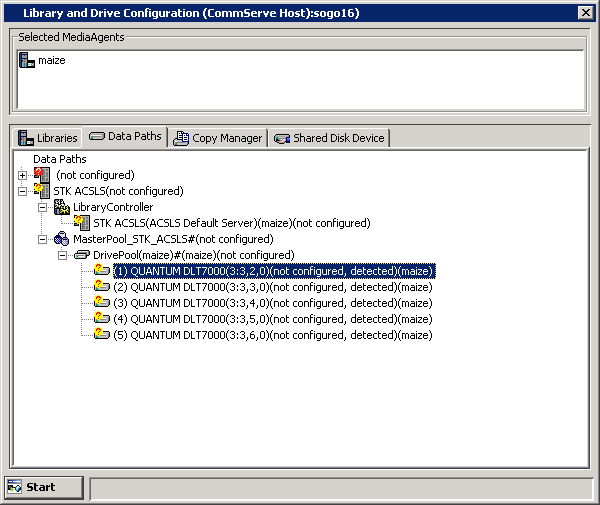
|
| 9. |
If you are not sure of the drive serial number and ACSLS drive ID mapping, then perform an exhaustive detection of the devices
from the Library Controller
level. This will ensure that the drives are
mapped to the appropriate serial number.
If necessary, use the following command on the ACSLS Console to display the
drives and its corresponding serial number:
display drive * -f serial_num
This would display results similar to the following:
2007-01-27 13:57:01 Display Drive
Acs Lsm Panel Drive Serial_num
0 0
2
0 CX803S1909
0 0
2
1 CX803S1939
0 0
2
2 CX803S1959
0 0
2
3 CX803S1979
0 0
2
4 CX803S2259
|
 |
| |
Select the most likely drives or all the available drives in the Select
Drive IDs dialog box. NOTES As this process attempts to mount a media in each of the selected drives to
determine the drive numbers to its correct serial number, depending on the number of drives
selected, this operation may take
some time to complete. |
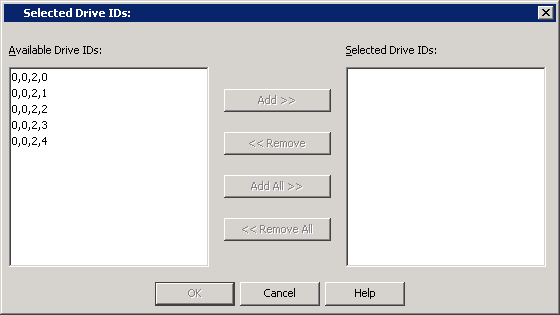 |
| |
Right-click the drive and then click Properties.
In the Drive Properties dialog box, verify that the Drive Serial
Number matches the Drive ID. |
 |
| 10. |
Configure the library as described in
Configure Devices.
The devices are displayed as
configured, detect success.
The Library tab provides
the physical view of the devices (library and drives).
NOTES:You can validate the physical drive configuration by
selecting Validate, from the drive, drive pool or library level. |
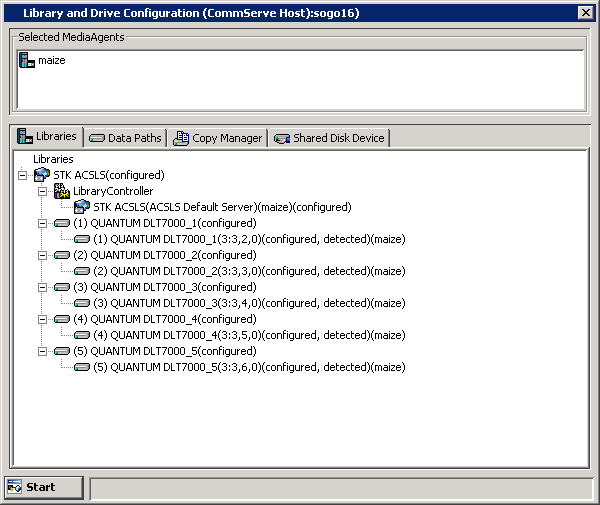 |
| |
The Data Paths tab provides a logical view of the data path used to access
the devices - library, master drive pool, drive pool, drive.
|
 |
Post Configuration Considerations
|
- If you have configured a library using SN6000, it is recommended that
you allocate the number of drives in the Drive Allocation Policy to the
number of physical drives in the library. For example, if you have 5
physical drives in the library, and you have virtualized it using SN6000 to
10 drives, set the number of drives in the Drive Allocation Policy to 5. For
step-by-step instructions on how to allocate drives in a drive allocation
policy, see
Set
the Maximum Number of Drives for each Drive Pool in a Master Drive Pool.
|
In a DDS configuration, all MediaAgents can be configured provided you have
at least one Windows or Solaris MediaAgent. (This MediaAgent is referred to as
the primary MediaAgent in this section.)
The following procedure describes the steps involved in configuring the STK
library attached to the ACSLS Server as a direct attached library (with or
without SN6000) using the Library and Drive Configuration window.
|
Before You Begin
|
Pre-configuration tasks in the ACSLS Server computer
Perform the following tasks in the ACSLS Server
on Solaris or STK Library Manager on Windows:
- Ensure that the hardware is configured according to the guidelines
provided in Hardware Configuration Guidelines - STK Libraries Attached to ACSLS Server.
(Solaris and Windows)
- Verify that the ACSLS server is online and the STK library is
functioning. (Solaris and Windows)
NOTES
See the STK/ACSLS documentation for instructions on verifying
the status of the ACSLS Server/STK library.
- In the ACSLS server, create a separate scratch pool in the library for the
exclusive use of the CommCell to which the MediaAgent(s) you wish to
configure are attached. (Solaris)
The MediaAgent uses a designated ACSLS scratch pool as its working media
pool. Make sure that the designated scratch pool contains all the media that
will be used by the MediaAgent. (See also:
Best Practices for STK Libraries Attached to ACSLS Server)
NOTES
See the STK/ACSLS documentation for
instructions on creating the scratch pool and moving the tapes to the
scratch pool.
- Move the necessary tapes into this scratch pool or use the Volume Range
in the Library Properties to add the necessary tapes. (Volume Range
is explained in the following procedure.) (Solaris)
Pre-configuration tasks in SN6000 (if available)
Ensure the following using the SN6000 interface:
- Verify that the drives in the library are visible and configured.
- Mount Queuing is disabled.
Pre-configuration tasks in the MediaAgent computer
- Ensure that the hardware is configured according to the guidelines
provided in Hardware Configuration Guidelines - STK Libraries Attached to ACSLS Server.
- Install one of the following software on a Windows or Solaris MediaAgent
that will act as the library controller. To configure failover library
controllers, install the following software on multiple MediaAgents that
will act as failover library controllers.
- For a Windows MediaAgent, install StorageTek's Library
Attach for Windows on the MediaAgent computer that will be
configured as the Library Controller. Make sure the library is
accessible through the specified ACSLS host server.
NOTES
See the STK/ACSLS documentation for instructions on installing the
Library Attach for Windows.
- For a Solaris MediaAgent, install the ACSLS Client Service. This
service can be installed in one of the following ways:
During the MediaAgent software installation on the Solaris computer. See
Install
the MediaAgent - Solaris for step-by-step instructions on
installing the MediaAgent software on Solaris.
If you have already installed the MediaAgent, you can run the
config_acsls
program on the Solaris MediaAgent computer: See
Install ACSLS Client Service on Solaris for step-by-step instructions .
-
This feature requires a Feature License to be available in the CommServe® Server.
Review general license requirements included in
License Administration. Also,
View All Licenses provides step-by-step
instructions on how to view the license information.
Required Capability: See
Capabilities and Permitted Actions |
To configure a StorageTek library with DDS
|
| 1. |
Display
the Library and Drive Configuration window.
|
|
| 2. |
In the Select MediaAgents dialog box, select the name of the MediaAgent in
which you have installed either the StorageTek’s Library Attach for Windows,or the ACSLS Client Service for Solaris. |
| 3. |
Follow steps in
Direct-attached Library Configuration (with or without SN6000) to configure the library
and drives in the primary MediaAgent. Once the library is configured, the Library and Drive Configuration
window will display a setup similar to the
following: |
 |
| 4. |
From the Library and Drive Configuration window, click the Start
menu and choose Select MediaAgents. Select the following MediaAgents:
- The MediaAgent in which the library is already configured.
- Another MediaAgent in which you wish to configure the library using DDS.
|
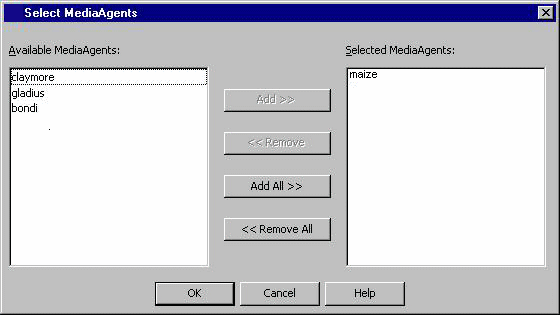 |
| 5. |
Detect the devices that are controlled by MediaAgents that will access the
library as described in
Detect Devices.
|
 |
Exhaustive detection operation does not provide any additional advantage on StorageTek libraries using ACSLS server. |
| 6. |
The system detects the drives and automatically displays them with the DDS setup in the
Library and Drive Configuration window. |
 |
| 7. |
Configure the Master Drive Pool.
Make sure that the drive pool and drives are configured. |
| 8. |
Repeat this procedure to configure another MediaAgent in the DDS setup. |
Post Configuration Considerations
|
- If you have configured a library using SN6000, it is recommended that
you allocate the number of drives in the Drive Allocation Policy to the
number of physical drives in the library. For example, if you have 5
physical drives in the library, and you have virtualized it using SN6000 to
10 drives, set the number of drives in the Drive Allocation Policy to 5. For
step-by-step instructions on how to allocate drives in a drive allocation
policy, see
Set
the Maximum Number of Drives for each Drive Pool in a Master Drive Pool.
|
| The following procedure describes the steps
involved in configuring the STK libraries with multiple LSMs attached to
the ACSLS Server using the Library and Drive Configuration window.
Due to the unique nature of this library, the goal of this configuration
is to eliminate the sharing of resources across LSMs. In order to do this,
each LSM is configured as a logical library. The following procedure describes
the steps involved in configuring a LSM as a virtual library. Repeat this
procedure to configure all the LSMs in the library.
|
Before You Begin
|
Pre-configuration tasks in the ACSLS Server computer
Perform the following tasks in the ACSLS Server computer in which the
library controller will be configured:
- Ensure that the hardware is configured according to the guidelines
provided in Hardware Configuration Guidelines
- STK Libraries Attached to ACSLS Server.
- Verify that the ACSLS server is online and the STK library is functioning.
NOTES
See the STK/ACSLS documentation for instructions on verifying the
status of the ACSLS Server/STK library.
- In the ACSLS server, create a scratch pool for each LSM. Ensure
that all volumes moved into each scratch pool reside in their respective
LSMs.
NOTES
See the STK/ACSLS documentation for instructions on creating the
scratch pool and moving the tapes to the scratch pool.
Pre-configuration tasks in the MediaAgent computer
- Ensure that the hardware is configured according to the guidelines
provided in ACSLS Library Configuration.
- Install one of the following, depending on the MediaAgent’s Operating
System:
For a Windows MediaAgent, install an instance of StorageTek’s
Library Attach for Windows on the computer in which the MediaAgent
will be installed.
NOTES
See the STK/ACSLS documentation for instructions on installing the
Library Attach for Windows.
- For a Solaris MediaAgent, install the ACSLS Client Service. This
service can be installed in one of the following ways:
- During the MediaAgent software installation on the Solaris computer.
See Install
the MediaAgent - Solaris for step-by-step instructions on installing
the MediaAgent software on Solaris.
- If you have already installed the MediaAgent, you can run the
config_acsls program on the Solaris
MediaAgent computer. See
Install ACSLS Client Service on Solaris for step-by-step
instructions .
- As each LSM is configured as a library, verify that you have sufficient
Library Control Module licenses available
in the CommServe.
-
This feature requires a Feature License to be available in the CommServe® Server.
Review general license requirements included in
License Administration. Also,
View All Licenses provides step-by-step
instructions on how to view the license information.
Required Capability: See
Capabilities and Permitted Actions
|
To configure a StorageTek library using ACSLS server (Direct-attached
library or SAN-DDS Configuration)
|
| 1. |
Display
the Library and Drive Configuration window.
|
 |
You cannot configure a StorageTek library attached
to ACSLS server from the Library and Drive Configuration window
displayed during the MediaAgent installation. |
| 2. |
Detect the devices as described in
Detect Devices.
Do not perform an Exhaustive Detection now.
|
| |
The devices are displayed in the library tree with detection
status not configured, detect success in
the Library and Drive Configuration window. If the system detects
the drives and displays them as a standalone library in the Library and
Drive Configuration window, perform the steps described in
Configuring
Drives Displayed as Stand-Alone Drives.
|
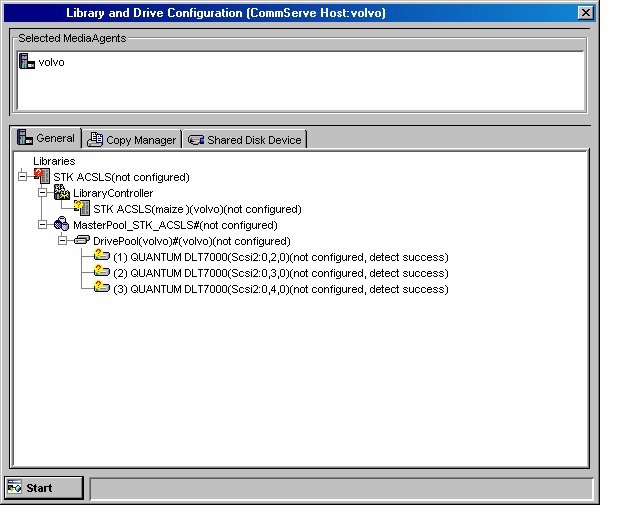 |
| 3. |
If you want to modify the library properties,
right-click the library and select Properties. From the Library
Properties dialog box, you can change the following properties:
Alias: The user-defined name for the library. This name is displayed
in the CommCell Console for the library. We recommend that you give each
library a descriptive name as its Alias, for easier system administration.
|
| 4. |
When you are satisfied with your changes, click
OK. |
| 5. |
Configure the library as described in
Configure Devices.
|
Perform the following steps, if you are configuring the library with
DDS
|
| 6. |
From the Library and Drive Configuration window,
click the Start menu and choose Select MediaAgents. Select
the following MediaAgents:
- The MediaAgent in which the library is already configured.
- Another MediaAgent in which you wish to configure the library using
DDS.
|
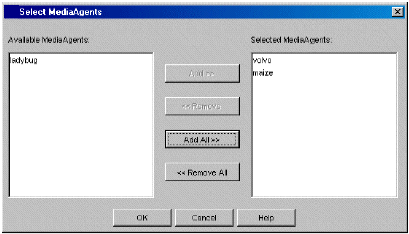 |
| 7. |
Detect the devices that are controlled by MediaAgents that will access the
library as described in
Detect Devices.
|
 |
Exhaustive detection operation does not provide
any additional advantage on StorageTek libraries using ACSLS server. |
| 8. |
The system detects the drives and automatically displays
them with the DDS setup in the Library and Drive Configuration window. |
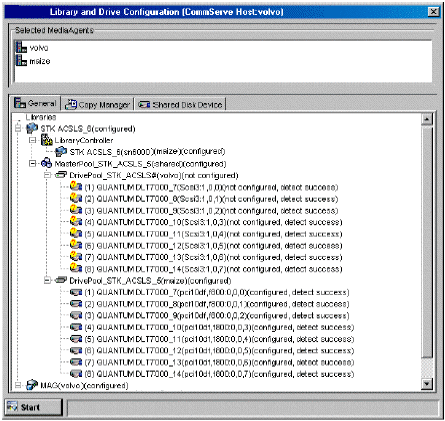 |
| 9. |
Configure the Master Drive Pool. Make sure that the drive pool and drives
are configured. |
| 10. |
Repeat steps 6 to 10 to configure another MediaAgent
in the DDS setup. |
Post-Configuration Considerations
|
Consider the following after configuring
all the LSMs as a virtual library:Creating Storage Policies
Recommended Method
When a library is configured, the system automatically creates a storage
policy. In the case of libraries with multiple LSMs, a storage policy will
be created for each of the LSMs configured as a library.
- Use one of these storage policies and associate all the subclients
using the library to this storage policy.
- Add the data paths for each LSM in the library as alternate data
paths in this storage policy. A data path for each LSM implies all possible
MediaAgents that have visibility to the drives in that LSM. (Review
Alternate
Data Paths (GridStor) for additional information. Also,
Configure Multiple Data Paths for a Storage Policy Copy provides
step-by-step instructions on how to configure alternate data paths.)
The advantages to this configuration method is that when there is failure
in any one of the LSMs , data protection operations will automatically use
the resources in the other LSM. Thus this configuration minimizes the impact
of a robot failure in any one of the LSMs. In addition only one storage
policy must be configured (and maintained) resulting in easier administration.
Note that data may get scattered across several tape cartridges within
the library. However, the system can keep track of all the data and automatically
restore data from the appropriate tape cartridge. In addition the MediaAgent
software provides several methods to reconsolidate the data. This is discussed
in the
Best Practices section for
Alternate
Data Paths (GridStor).
Other Methods
|
|
|
|
Perform the following steps if the system detects the drives
and displays them as a standalone library in the Library and Drive Configuration
window, as shown in the sample image. |
 |
| |
From the Library and Drive Configuration
window, click the Start menu, choose Add and then select
IP Library from the shortcut menu. |
| |
In the Add IP Library dialog box, enter/select the
following information: MediaAgent: The name of the MediaAgent controlling
the library.
Library Type: The IP library type. (ACSLS)Library Host Name:
The host name of the ACSLS server. If you have SN6000 attached, the host
name of SN6000.
Work Pool Number: The work pool number associated with the work pool
created for the system in the ACSLS server.
As we are configuring a library for each LSM, make sure to specify the
appropriate work pool number associated with the LSM.
Volume Range: The ascending barcode range(s) of volumes available
in the specified work pool. Use a dash to specify range and commas to delimit
ranges. For example: 000065-000165,000167,000170-000199.
Vendor: The manufacturer of the library. (STK)
Model: The library model. (ACSLS)Description: An optional
field into which you can enter a description for the library
Drive Count: The number of drives in the library. |
 |
| |
When you are finished, click OK.
The system detects the library and displays the library information in
the Library and Drive Configuration window.
|
 |
| |
Right-click a stand-alone drive and choose the Move
To option. |
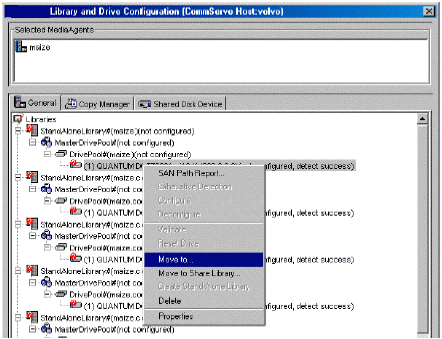 |
| |
In the Move to the Empty Drive Slot dialog box click
the drive number to which you wish to move the standalone drive. |
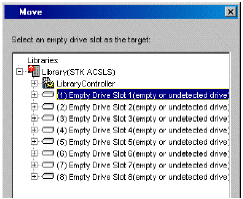 |
| |
Click OK. |
| |
Click Yes in the confirmation prompt
for moving the drive to the empty slot. |
| |
Repeat steps 8 to 11 to move all other associated
stand-alone drives to the appropriate drive slots in the library tree. |
| |
The devices are displayed in the library tree with detection
status not configured, detect success in
the Library and Drive Configuration window. |
 |
| |
Right-click the drive and then click Properties. |
|
| |
In the Drive Properties dialog box, select the correct
ACSLS Drive ID to match the Serial Number of the physical
drive in the library. Verify the drive serial number and obtain the corresponding
drive ID, before selecting the drive ID in this dialog box.
To assist in this mapping operation, use the following ACSLS command
on the ACSLS server to map the Serial Number to the ACSLS Drive ID:
To obtain the serial number of a specific drive:
display drive <ACSLS Drive ID> -f serial_num
To obtain the serial number of all drives:
display drive * -f serial_num
|
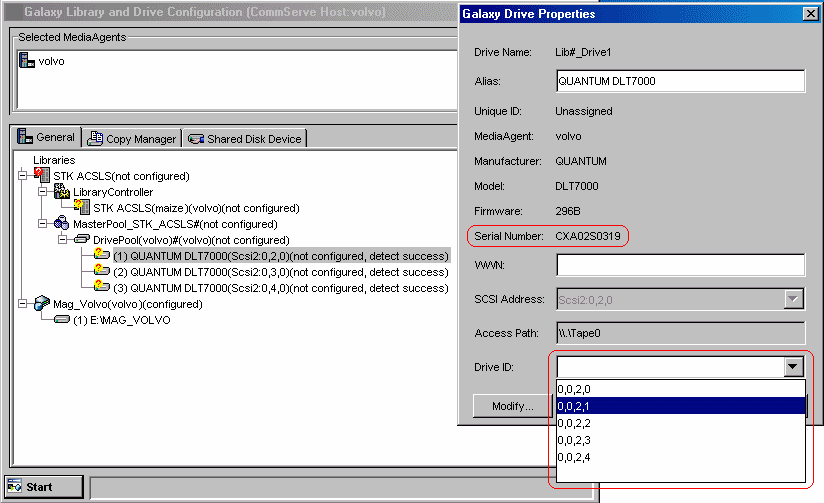 |
 |
If the list of the ACSLS drive IDs is not populated,
verify and ensure that the ACSLS Client Service is running. |
| |
Repeat steps 14 to 15 for all the drives within
each LSM in the library. |
| |
If you are not sure of the drive serial number and drive
ID mapping, then perform an exhaustive detection of the devices at the Library
Controller level. This will ensure that the drives are mapped to the appropriate
serial number.
|
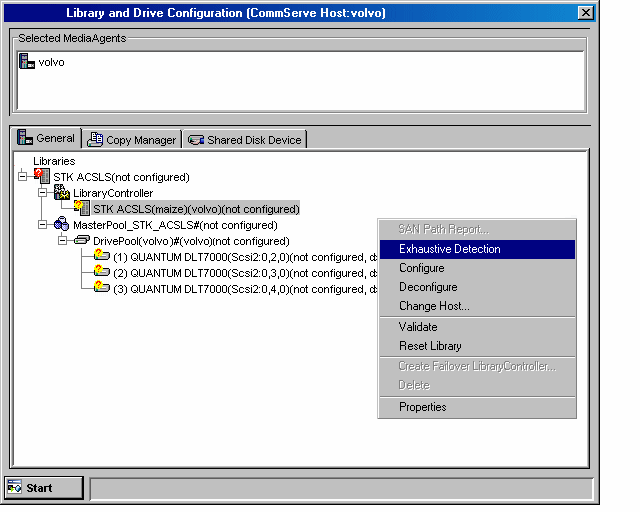 |
| |
Select the most likely drives or all the available drives
in the Select Drive IDs dialog box. NOTES
As this process attempts to mount a media in each of the selected drives
to determine the drive numbers to its correct serial number, depending on
the number of drives selected, this operation may take several minutes to
complete.
|
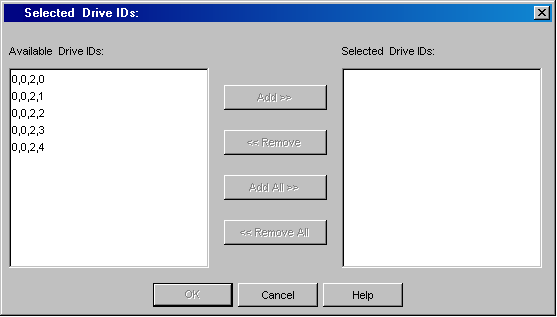 |
| |
Proceed to Step 3. |






















